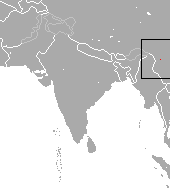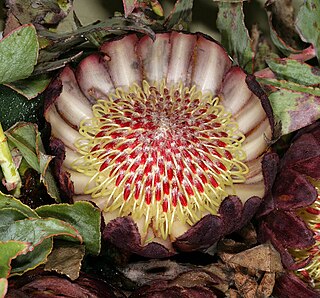
Herring are forage fish, mostly belonging to the family of Clupeidae.

Wobbegong is the common name given to the 12 species of carpet sharks in the family Orectolobidae. They are found in shallow temperate and tropical waters of the western Pacific Ocean and eastern Indian Ocean, chiefly around Australia and Indonesia, although one species occurs as far north as Japan. The word wobbegong is believed to come from an Australian Aboriginal language, meaning "shaggy beard", referring to the growths around the mouth of the shark of the western Pacific.

The northern giraffe, also known as three-horned giraffe, is the type species of giraffe, G. camelopardalis, and is native to North Africa, although alternative taxonomic hypotheses have proposed the northern giraffe as a separate species.

The fringefin lanternshark is a shark of the family Etmopteridae found in the western central Atlantic from Texas to Florida, northern Gulf of Mexico, and Mexico. It is endemic to this area. It is a deep water shark and is found about 220 to 915 meters below the surface, on the upper continental slopes of the Gulf. E. schultzi is a small shark, about 27–30 cm long and feeds on squid. It is also bioluminescent, which counter-illuminates it and helps with intraspecific interaction. Due to its limited range and the difficulty of collecting deep water species, it has not been evaluated by the IUCN Red List, but due to recent oil spills in the Gulf of Mexico, it is likely that fringefin lanternsharks have decreased in population.
This article is a list of biological species, subspecies, and evolutionary significant units that are known to have become extinct during the Holocene, the current geologic epoch, ordered by their known or approximate date of disappearance from oldest to most recent.
The Ghana rufous-nosed rat, also known as the West African Oenomys, is a species of rodent in the family Muridae. It is found in Ivory Coast, Ghana, Guinea, Liberia, and Sierra Leone. Its natural habitats are subtropical or tropical seasonally wet or flooded lowland grassland and seasonally flooded agricultural land, it has also been observed in secondary high forest habitat.
Sanborn's squirrel is or was a little known tree squirrel described in 1944 from the skin and skeleton of a single female specimen collected in Peru in 1941. Subsequently, over the proceeding years only a handful of either specimens were collected, or observations were recorded, in the regions of Madre de Dios and northern Puno in Peru, and Pando department in Bolivia. The 2019 IUCN assessment describes it as endemic to Peru. In 2015 this taxon was synonymised with Notosciurus pucheranii ssp. boliviensis. Its habitat is tropical dry broadleaf forests at elevations up to 570 m. It is considered possibly rare and potentially vulnerable to deforestation, but its population trend is not established.

The pygmy brown-toothed shrew is a species of shrew in the order Eulipotyphla. It is distributed in China. C. parva was initially thought to be the same as Chodsigoa lamula, but it was found to be a separate species.
Hipposideros alongensis, known as the Ha Long leaf-nosed bat, is a species of bat in the family Hipposideridae. It is endemic to Vietnam. It is listed as a vulnerable species by the IUCN.

Myriophyllum heterophyllum is a species from the genus Myriophyllum native to North America. It was first described by André Michaux.

Leucadendron conicum, the garden route conebush, is a flower-bearing shrub that belongs to the genus Leucadendron and part of the fynbos form. The plant is native to the Western Cape and the Eastern Cape, where it occurs in the Langeberg, Outeniqua Mountains, Tsitsikamma Mountains, Elandsberg and Garden Route plain.The shrub grows to be 6 m and bears flowers from October to November.

Protea amplexicaulis, the clasping-leaf sugarbush, is a flower-bearing shrub that belongs to the genus Protea. The plant is endemic to the Cape Provinces of South Africa and occurs from Citrusdal to the Kogelberg, as well as in the Langeberg. The shrub remains low and spreads out, becoming 1.3 m in diameter and flowering from June to September.
Serruria altiscapa, the stately spiderhead, is a flower-bearing shrub that belongs to the genus Serruria and forms part of the fynbos. The plant is native to the Western Cape and occurs at Blokkop in Villiersdorp as far as the Hottentots-Holland Mountains.









